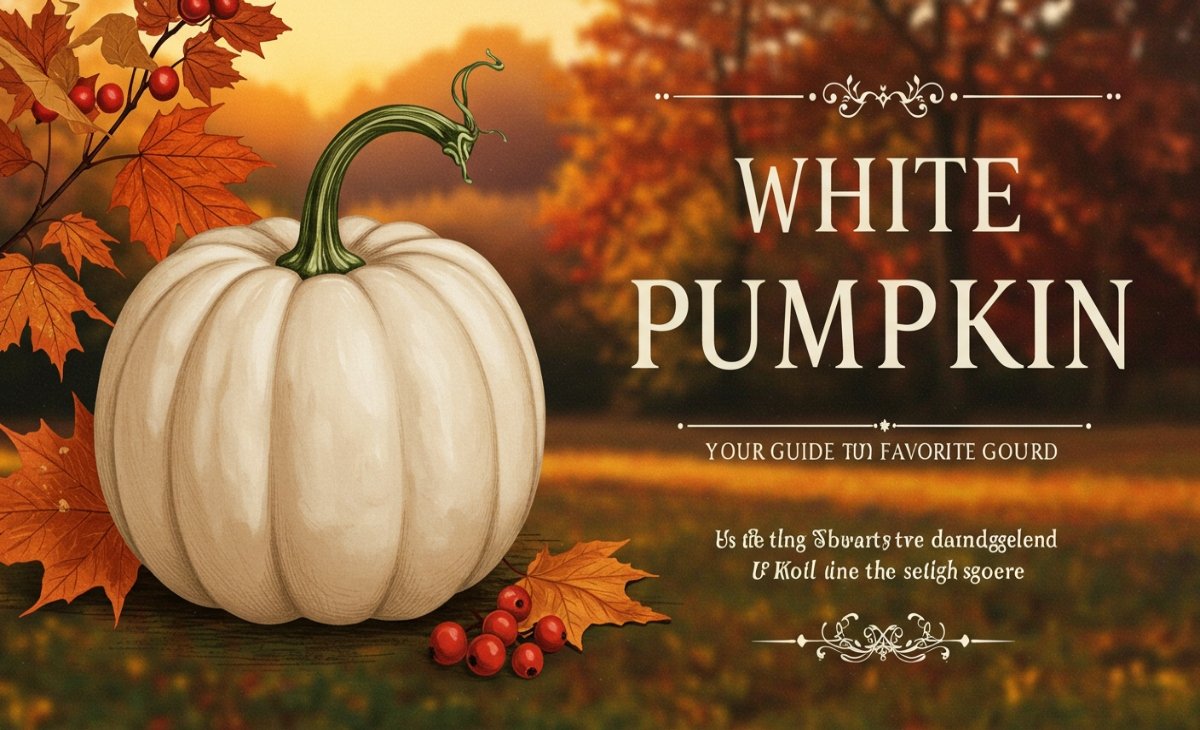Blog
White Pumpkin: Your Guide to Fall’s Favorite Gourd

The crisp air, the changing leaves, and the aroma of pumpkin spice often signal the arrival of fall. While many picture the classic orange pumpkin, there’s another star of the season that’s been quietly gaining popularity: the white pumpkin. These pale beauties offer a fresh twist on traditional autumn decor and culinary delights. If you’ve ever wondered about these ghostly gourds, you’re in the right place. We’re about to explore everything from their unique appeal to how you can grow them and even enjoy them in your kitchen.
What Makes White Pumpkins So Special?
White pumpkins are more than just a pretty face; they bring a lot to the table, literally and figuratively. Unlike their vibrant orange cousins, white pumpkins boast a creamy, off-white to pure white rind. This distinct color isn’t due to a lack of sunlight or a genetic flaw; it’s simply a natural variation that plant breeders have cultivated over time. In addition, their smooth, often slightly ribbed exterior gives them an elegant and modern look that appeals to many.
While their appearance is a major draw, these pumpkins also offer a mild, slightly sweeter flavor compared to some traditional orange varieties. This makes them incredibly versatile for cooking, as their subtle taste won’t overpower other ingredients. Consequently, they’ve become a favorite for both decorative purposes and delicious autumnal dishes.
You Might Also Like: Blue Orchid
The Different Types of White Pumpkins
Just like orange pumpkins, white pumpkin varieties come in various shapes and sizes, each with its own charm and purpose. Knowing the different types can help you choose the perfect one for your needs, whether you’re decorating your porch or preparing a feast.
Lumina
Perhaps the most well-known white pumpkin, ‘Lumina’ is famous for its bright white skin and round, slightly flattened shape. These pumpkins typically weigh between 10 and 15 pounds, making them ideal for carving or painting. However, they also have a good amount of flesh, which is perfect for pies, soups, or roasting. Many people love Lumina for its classic pumpkin shape combined with its striking white color.
Cotton Candy
As its name suggests, ‘Cotton Candy’ pumpkins are known for their pure white color and smooth texture. They are usually smaller than Lumina, often weighing 5 to 10 pounds. This makes them excellent for tabletop decorations or as part of a larger fall display. Their size and appealing color also make them popular for children’s fall crafts.
Baby Boo
If you’re looking for something miniature and adorable, ‘Baby Boo’ is your white pumpkin of choice. These tiny gourds are usually no bigger than a golf ball or a small apple, with a pure white skin. They are often used as decorative accents in bowls, on mantels, or as part of centerpieces. While they are edible, their small size means there isn’t much flesh to work with, so they are primarily grown for ornamental purposes.
Polar Bear
For those who want a truly giant white pumpkin, ‘Polar Bear’ is an impressive variety. These can grow to enormous sizes, often exceeding 50 pounds, with some reaching several hundred pounds! They have a slightly ribbed, bright white skin and are primarily grown for display at pumpkin patches or fall festivals. In addition, their sheer size makes them a real showstopper.
Growing Your Own White Pumpkins
Cultivating your own white pumpkin patch can be a rewarding experience, allowing you to enjoy fresh, homegrown gourds right from your backyard. However, growing white pumpkins is quite similar to growing their orange counterparts, with a few key considerations to ensure success.
Choosing the Right Spot
Pumpkins are sun-loving plants, so select a location in your garden that receives at least six to eight hours of direct sunlight daily. Moreover, they need plenty of space to spread out. Therefore, if you’re growing vine varieties, ensure you have a large area, or consider training them on a sturdy trellis if space is limited. Good air circulation is also important to prevent diseases.
Soil Preparation
White pumpkins thrive in rich, well-draining soil. Before planting, amend your soil with plenty of organic matter, such as compost or well-rotted manure. This will provide essential nutrients and improve soil structure. The ideal soil pH for pumpkins is between 6.0 and 6.8, which is slightly acidic to neutral.
Planting Your Seeds
Wait until all danger of frost has passed and the soil has warmed up, typically in late spring or early summer. Plant white pumpkin seeds about 1 inch deep and 3-5 feet apart in mounds or rows. If planting in mounds, place 3-5 seeds per mound and thin them to the strongest 1-2 plants once they have a few true leaves. This gives the plants ample room to grow.
Watering and Fertilizing
Pumpkins are thirsty plants, especially when the fruits are developing. Water deeply and regularly, aiming for about 1 inch of water per week, either from rainfall or irrigation. Try to water the base of the plant to keep the leaves dry, which can help prevent fungal diseases. In addition, a balanced fertilizer applied when the vines start to run and again when fruits begin to set will promote healthy growth. However, avoid too much nitrogen once flowering begins, as this encourages leaf growth over fruit production.
Pollination and Pests
For pumpkins to produce fruit, their flowers need to be pollinated. Bees are excellent pollinators, so encouraging them in your garden is beneficial. If you notice a lack of fruit, you might need to hand-pollinate by transferring pollen from male flowers to female flowers. Meanwhile, keep an eye out for common garden pests like squash bugs and cucumber beetles, and address them promptly using organic pest control methods if possible.
Harvesting Your White Pumpkins
White pumpkins are typically ready for harvest in late summer or early fall, usually around 90-120 days after planting, depending on the variety. You’ll know they’re ripe when the skin is hard and resistant to your fingernail, and the stem has begun to dry and turn woody. Use sharp pruning shears or a knife to cut the pumpkin from the vine, leaving a few inches of stem attached. This stem helps the pumpkin store longer.
Health Benefits of White Pumpkin
Beyond their beauty and versatility in the kitchen, white pumpkin varieties offer a surprising array of health benefits. Indeed, incorporating them into your diet can be a delicious way to boost your overall wellness.
Rich in Nutrients
White pumpkins are packed with essential vitamins and minerals. They are a good source of Vitamin A, crucial for vision, immune function, and skin health. In addition, they provide Vitamin C, an antioxidant that supports the immune system, and Vitamin K, important for blood clotting and bone health.
Full of Antioxidants
Like many fruits and vegetables, white pumpkins contain antioxidants that help protect your body’s cells from damage caused by free radicals. This can reduce the risk of chronic diseases and contribute to overall cellular health.
Good for Digestion
With a good amount of dietary fiber, white pumpkins can aid in healthy digestion. Fiber adds bulk to stool, promoting regularity and preventing constipation. Furthermore, it can contribute to a feeling of fullness, which can be helpful for weight management.
Hydrating
Pumpkins have a high water content, making them a hydrating food. Staying well-hydrated is vital for numerous bodily functions, including nutrient transport, temperature regulation, and joint lubrication.
Supports Heart Health
The potassium content in white pumpkins can help maintain healthy blood pressure levels, which is beneficial for heart health. Moreover, the fiber and antioxidants found in pumpkins also contribute to a healthy cardiovascular system.
Culinary Uses for White Pumpkin
One of the most exciting aspects of white pumpkin is its versatility in the kitchen. Its mild, slightly sweet flavor means it can be used in both sweet and savory dishes, offering a unique twist to your fall cooking.
Roasting
Roasting is one of the simplest and most delicious ways to enjoy white pumpkin. Simply cut the pumpkin into chunks, toss with a little olive oil, salt, pepper, and your favorite herbs (like sage or thyme), and roast until tender and slightly caramelized. Roasted white pumpkin makes a fantastic side dish or can be added to salads and grain bowls.
Soups and Stews
White pumpkin’s creamy texture makes it an excellent base for rich and comforting soups. A classic white pumpkin soup, often blended with vegetable broth, onions, garlic, and spices like nutmeg and ginger, is a perfect warm-up on a chilly day. It can also be added to stews to thicken them and add a subtle sweetness.
Baked Goods
While often associated with savory dishes, white pumpkin shines in baked goods. Its mild flavor won’t overpower delicate desserts. Think white pumpkin bread, muffins, or even a white pumpkin pie with a hint of vanilla or cinnamon. The flesh can be pureed and used just like regular pumpkin puree in most recipes.
Puree
Making your own white pumpkin puree is simple and allows you to control the freshness and flavor. Roast pumpkin chunks until very soft, then blend them in a food processor until smooth. This homemade puree can be stored in the refrigerator or frozen for later use in a variety of dishes.
Decorating with White Pumpkins
The elegant simplicity of white pumpkin makes them a favorite for fall and Halloween decor, moving beyond the traditional orange and black. They offer a sophisticated and versatile aesthetic that can complement almost any style.
Modern and Minimalist Displays
Their clean lines and neutral color make white pumpkins perfect for modern and minimalist decor. Arrange them simply on a mantelpiece, a console table, or grouped on a porch step. Pair them with subtle greenery, metallic accents, or natural wood elements for a chic look.
Painting and Crafting
The smooth surface of white pumpkins makes them an ideal canvas for painting. You can create intricate designs, use metallic paints for a glamorous touch, or simply draw spooky faces for Halloween without the mess of carving. This is a particularly popular activity for families.
Elegant Centerpieces
Combine white pumpkins of varying sizes with candles, flowers (especially white or deep jewel-toned blooms), and seasonal foliage to create stunning centerpieces for your dining table. Their neutral color allows them to blend seamlessly with other autumnal elements, enhancing their beauty.
Mixing with Other Gourds
Don’t be afraid to mix and match! White pumpkins look fantastic when combined with other gourds, squashes, and traditional orange pumpkins. The contrast in colors and textures creates a dynamic and visually interesting display.
The History of White Pumpkins
While they seem like a modern invention, white pumpkin varieties have a fascinating history rooted in agricultural innovation. For centuries, pumpkins were cultivated primarily for their flesh. However, around the mid-20th century, horticulturists began to focus on developing pumpkins with unique colors and shapes, often for ornamental purposes.
The development of truly white pumpkins, like ‘Lumina,’ was a significant breakthrough in the late 20th century. These varieties were selectively bred from existing pumpkin lines that exhibited natural genetic mutations leading to a lack of orange pigment. Farmers and breeders noticed these rare white-skinned pumpkins and began to cross-pollinate them, gradually stabilizing the trait and enhancing characteristics like size, shape, and skin texture. This careful breeding process led to the array of beautiful white pumpkins we enjoy today, offering a refreshing alternative to the traditional orange for both decoration and culinary adventures.
Embracing the Versatility of White Pumpkins
From their striking appearance to their subtle flavor and health benefits, white pumpkin offers a fresh perspective on a classic fall staple. Whether you’re a seasoned gardener, a culinary enthusiast, or simply looking to update your autumn decor, these elegant gourds provide endless possibilities. Their growing popularity is a testament to their versatility and charm, proving that sometimes, the simplest changes can make the biggest impact. So, this fall, consider picking up a white pumpkin—or even growing your own—and discover all the unique ways it can enrich your home and your kitchen.

 Blog7 months ago
Blog7 months ago[PPT] Human Reproduction Class 12 Notes
- Blog7 months ago
Contribution of Indian Phycologists (4 Famous Algologist)
- Blog7 months ago
PG TRB Botany Study Material PDF Free Download

 Blog7 months ago
Blog7 months agoCell The Unit of Life Complete Notes | Class 11 & NEET Free Notes

 Blog7 months ago
Blog7 months ago[PPT] The living world Class 11 Notes

 Blog7 months ago
Blog7 months agoClassification of Algae By Fritsch (11 Classes of Algae)

 Blog7 months ago
Blog7 months agoJulus General Characteristics | Free Biology Notes

 Blog7 months ago
Blog7 months agoPlasma Membrane Structure and Functions | Free Biology Notes














